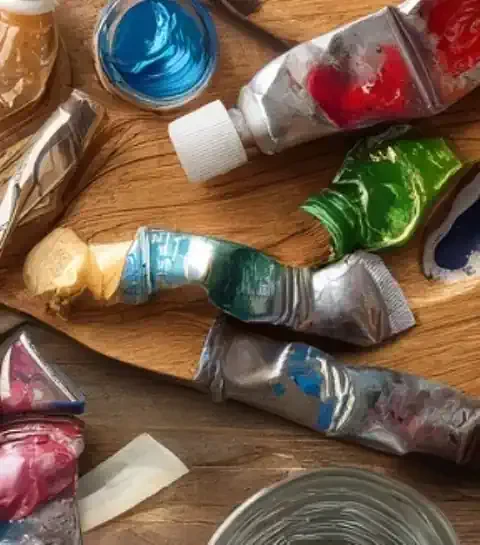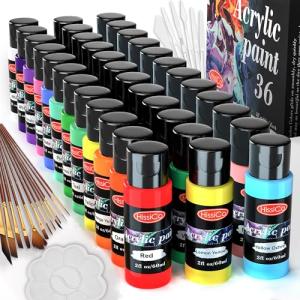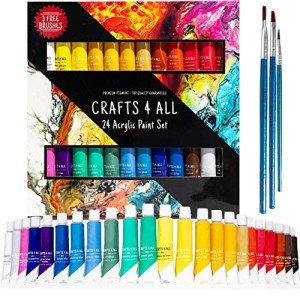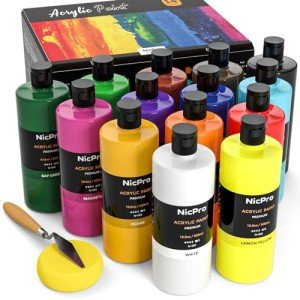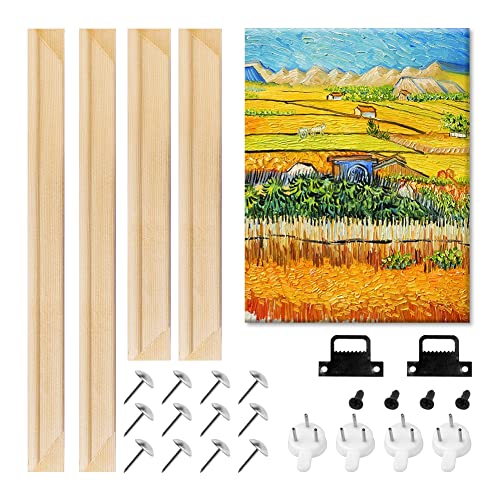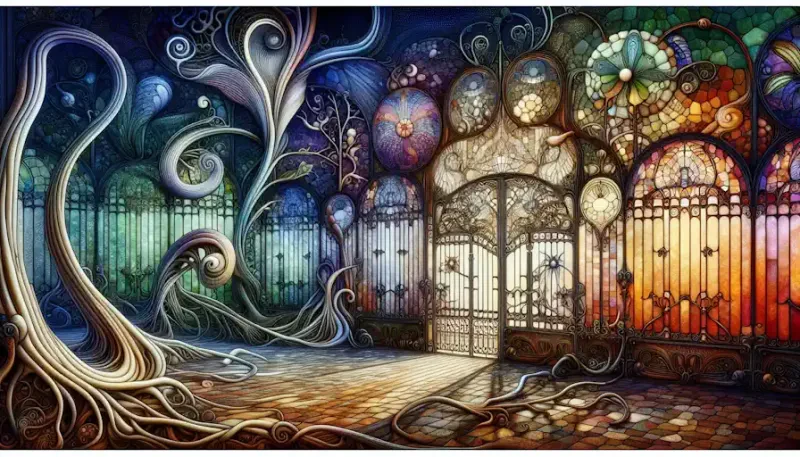Introduction
Art is a realm where imagination meets tangible expression, and at the heart of this creative journey lies a vast array of art supplies. Whether you're a seasoned artist or an enthusiastic beginner, the significance of these supplies cannot be overstated. They are the tools that translate ideas into reality, shaping every stroke, line, and color on the canvas.
A. Brief overview of the importance of art supplies in creating artwork
Art supplies form the cornerstone of artistic expression, serving as the conduits through which artists channel their visions onto various surfaces. From the humble pencil to the vibrant hues of oil paints, each tool and material holds the power to transform blank canvases into captivating masterpieces. Without the right supplies, the creative process would be akin to navigating uncharted waters without a compass. They provide artists with the means to experiment, innovate, and ultimately bring their artistic visions to life.
B. Introduction to the purpose and structure of the glossary
In light of the vast and diverse landscape of art supplies, this glossary serves as a guiding beacon, illuminating the nuances of each tool, medium, and accessory. Organized in a systematic manner, it aims to demystify the world of art supplies, offering clarity to both novice and seasoned artists alike. From basic tools to specialized mediums, each entry provides valuable insights, helping artists make informed choices and refine their craft.
C. Significance of understanding different art supplies for artists and enthusiasts
Understanding art supplies goes beyond mere familiarity with tools and materials; it is about empowering artists to unleash their creative potential. By delving into the characteristics, uses, and techniques associated with each supply, artists gain a deeper appreciation for their craft. Moreover, this knowledge fosters experimentation and innovation, enabling artists to push the boundaries of their creativity. For enthusiasts, this glossary serves as a gateway to the vibrant world of art, inviting exploration and discovery. Whether one aspires to create art or simply appreciates its beauty, a comprehensive understanding of art supplies enriches the artistic experience and fosters a deeper connection with the creative process.
Understanding Basic Tools
A. Definition and Explanation of Essential Tools
In the realm of artistry, basic tools are the foundation upon which every masterpiece is built. Among these foundational tools are pencils, erasers, and sharpeners.
Pencils: Pencils come in various grades, ranging from 9H (hardest) to 9B (softest), each offering different levels of hardness or softness. The hardness of a pencil affects the darkness of the line it produces, with softer pencils creating darker lines. Artists often use a range of pencils to achieve varying levels of detail and shading in their work.
Erasers: Erasers are indispensable tools for correcting mistakes and refining details in artwork. Different types of erasers are available, including kneaded erasers, which can be shaped to create precise erasures, and vinyl erasers, which are more suitable for larger areas. Each type of eraser offers unique advantages and is chosen based on the specific needs of the artist.
Sharpeners: Sharpeners are essential for maintaining the fine point of pencils, ensuring precision and accuracy in drawing. Manual sharpeners are commonly used for standard pencils, while electric sharpeners offer convenience and efficiency, particularly for artists working with a large volume of pencils.
B. Variations in Quality and Types of Basic Tools
While pencils, erasers, and sharpeners may seem straightforward, there is a wide range of variations in quality and types available in the market. High-quality pencils are made with superior materials, resulting in smoother and more consistent lines. Similarly, premium erasers offer better erasing performance and durability compared to their lower-quality counterparts. When it comes to sharpeners, factors such as blade sharpness and durability determine their effectiveness in maintaining pencil points.
C. Importance of Selecting the Right Basic Tools for Different Artistic Techniques
The importance of selecting the right basic tools cannot be overstated, as they directly impact the outcome of artistic endeavors. Different artistic techniques require specific tools to achieve desired effects. For instance, detailed drawings may necessitate the use of fine-tipped pencils and precision erasers, while expressive sketches may benefit from softer pencils and kneaded erasers for blending and shading. By understanding the characteristics and capabilities of each tool, artists can make informed decisions that enhance their artistic expression and craftsmanship.
Exploring Drawing and Sketching Materials
A. Definition and Description of Different Types of Drawing Materials
Drawing materials encompass a rich variety of mediums, each offering unique qualities and possibilities for artistic expression. Among these are pens, markers, charcoal, and more.
Pens: Pens come in an array of types, including ballpoint, gel, fountain, and technical pens. They offer precise lines and are suitable for both fine detail work and bold strokes. Gel pens provide smooth and vibrant lines, while fountain pens offer a more traditional and elegant writing experience. Technical pens are favored by illustrators for their consistent line widths and archival quality.
Markers: Markers are beloved for their vibrant colors and versatility. They come in various types, including alcohol-based, water-based, and permanent markers. Alcohol-based markers, such as Copic markers, blend seamlessly and offer a wide range of colors. Water-based markers, like Tombow Dual Brush pens, are ideal for blending and creating watercolor effects. Permanent markers, such as Sharpies, provide bold, long-lasting lines on a variety of surfaces.
Charcoal: Charcoal is prized for its rich, velvety texture and dramatic contrasts. It comes in various forms, including vine charcoal, compressed charcoal, and charcoal pencils. Vine charcoal is soft and easily smudged, making it ideal for quick sketches and gestural drawings. Compressed charcoal offers darker, more intense lines and is suitable for bold, expressive work. Charcoal pencils provide greater control and precision, allowing artists to create detailed drawings with ease.
B. Characteristics and Uses of Each Type of Drawing Material
Each type of drawing material possesses distinct characteristics that influence its uses and applications in artwork.
Pens: Pens offer precision and control, making them ideal for technical drawings, illustrations, and fine line work. They are commonly used in comic art, architectural sketches, and detailed renderings.
Markers: Markers provide vibrant colors and bold lines, making them well-suited for illustration, graphic design, and coloring artwork. They are popular among artists, designers, and hobbyists for their versatility and ease of use.
Charcoal: Charcoal is prized for its expressive qualities and ability to create dynamic contrasts. It is commonly used for life drawing, portrait sketches, and expressive artworks where bold, gestural marks are desired.
C. Tips for Selecting the Appropriate Drawing Material Based on the Desired Effect
When selecting drawing materials, it is essential to consider the desired effect and intended application of the artwork.
For precise line work and intricate detail, pens and technical pens are excellent choices. Gel pens offer smooth, consistent lines, while fountain pens provide a more traditional feel.
For vibrant colors and bold lines, markers are an excellent option. Alcohol-based markers offer seamless blending, while water-based markers provide a watercolor-like effect.
For expressive and dramatic drawings, charcoal is unmatched. Vine charcoal is ideal for loose, gestural sketches, while compressed charcoal and charcoal pencils offer greater control and versatility.
Experimenting with different drawing materials and techniques can lead to exciting discoveries and unexpected results. Don't be afraid to mix and match materials to achieve the desired effect and bring your artistic vision to life.
Diving into Painting Mediums
Painting mediums offer artists a diverse range of possibilities, from bold and vibrant acrylics to the rich and timeless qualities of oils. Understanding the characteristics and techniques associated with each medium is essential for artists seeking to express their vision on canvas.
A. Overview of Various Painting Mediums
Painting mediums encompass a broad spectrum of materials, each with its own unique properties and applications:
Acrylics: Known for their fast-drying nature and versatility, acrylic paints consist of pigment suspended in a water-based acrylic polymer emulsion. They can be thinned with water or acrylic mediums to create translucent washes or applied thickly for textured effects.
Oils: Oil paints are revered for their rich colors, slow drying time, and blendability. They are composed of pigment suspended in a drying oil, typically linseed oil. Oils offer artists the ability to work wet-on-wet, allowing for seamless blending and layering of colors.
Watercolors: Watercolor paints consist of pigments suspended in a water-soluble binder, usually gum arabic. They are renowned for their transparent quality and luminous effects. Watercolors are traditionally applied to paper, with the white of the paper serving as the lightest value in the painting.
Gouache: Gouache is similar to watercolor but contains a higher concentration of pigment and an opaque binder, such as gum arabic or dextrin. It can be layered and reworked, making it suitable for both transparent washes and opaque passages.
B. Detailed Description of Each Painting Medium
Acrylics: Acrylic paints dry quickly to a flexible, water-resistant finish. They can be used on a variety of surfaces, including canvas, paper, wood, and fabric. Acrylics offer vibrant colors and can be thinned with water for transparent washes or layered for impasto effects. Techniques such as dry brushing, glazing, and pouring are commonly employed with acrylics.
Oils: Oil paints have a slow drying time, allowing artists ample time to manipulate the paint on the canvas. They offer rich, intense colors and can be thinned with turpentine or linseed oil for different effects. Oils are well-suited for alla prima (wet-on-wet) painting as well as glazing and scumbling techniques.
Watercolors: Watercolor paints are transparent and luminous, allowing light to pass through the layers of paint. They are typically applied using wet-on-wet or wet-on-dry techniques, with the white of the paper serving as the lightest value. Watercolors can be layered to build up depth and intensity, or lifted to create highlights.
Gouache: Gouache offers the best of both worlds, combining the transparency of watercolor with the opacity of acrylics. It dries to a matte finish and can be reactivated with water even after it has dried. Gouache is popular for illustration, design work, and detailed paintings.
C. Considerations for Choosing the Right Painting Medium
When selecting a painting medium, artists should consider their artistic goals, preferences, and working methods:
Acrylics are ideal for artists seeking a fast-drying, versatile medium with vibrant colors and a range of techniques.
Oils are well-suited for artists who prefer a slow-drying medium with rich colors and blendability.
Watercolors offer transparency and luminosity, making them suitable for plein air painting and capturing the subtleties of light and atmosphere.
Gouache is a versatile medium that combines the best qualities of watercolor and acrylics, making it suitable for a variety of applications.
Ultimately, the choice of painting medium depends on the artist's individual style, subject matter, and desired aesthetic. Experimentation and exploration are key to finding the medium that best suits one's artistic vision and expression.
Unveiling the World of Brushes
A. Introduction to Different Types of Brushes
Brushes are the unsung heroes of the painting world, wielding the power to shape and define every stroke on the canvas. Understanding the various types of brushes is essential for artists seeking to master their craft.
Round Brushes: Round brushes have a pointed tip and are versatile for creating both thin lines and broad strokes. They are commonly used for outlining, detailing, and adding fine textures.
Flat Brushes: Flat brushes have a rectangular-shaped ferrule and are ideal for covering large areas with broad, sweeping strokes. They are commonly used for laying down washes, blocking in shapes, and applying varnishes.
Filbert Brushes: Filbert brushes have a flat, oval-shaped tip that tapers to a point. They combine the versatility of round and flat brushes, making them suitable for blending, softening edges, and creating organic shapes.
Fan Brushes: Fan brushes have bristles arranged in a fan shape and are primarily used for blending, creating textures, and softening edges. They are especially useful for painting foliage, clouds, and other natural elements.
Detail Brushes: Detail brushes have a fine, pointed tip and are designed for intricate work and fine details. They are commonly used for adding highlights, refining edges, and creating intricate patterns.
B. Explanation of Brush Materials and Their Impact on Painting Techniques
Brushes are available in a variety of materials, each with its own unique characteristics and impact on painting techniques:
Synthetic Brushes: Synthetic brushes are made from nylon or polyester fibers and are durable, resilient, and easy to clean. They are suitable for use with acrylics, watercolors, and gouache.
Natural Hair Brushes: Natural hair brushes are made from animal hair, such as sable, hog, or squirrel. They offer excellent water retention, spring, and control, making them ideal for use with oils and watercolors.
Blended Brushes: Blended brushes combine synthetic and natural hair fibers to offer the benefits of both materials. They provide the durability of synthetic brushes with the softness and water retention of natural hair brushes.
C. Tips for Selecting the Appropriate Brush for Specific Painting Tasks and Styles
When selecting brushes for painting, it is essential to consider the specific painting tasks and styles:
For detailed work and fine lines, choose brushes with a fine, pointed tip, such as round or detail brushes.
For covering large areas and laying down washes, opt for flat or filbert brushes with a broad, flat tip.
Consider the type of paint you will be using and choose brushes that are compatible with the medium (e.g., synthetic brushes for acrylics, natural hair brushes for oils).
Experiment with different brush shapes and sizes to discover their unique qualities and effects on your painting style.
Invest in high-quality brushes that are well-made and durable, as they will provide better performance and longevity.
By understanding the various types of brushes, their materials, and their impact on painting techniques, artists can confidently select the appropriate tools to bring their artistic visions to life on the canvas.
Surveying Surfaces and Supports
A. Definition and Explanation of Various Surfaces and Supports for Artwork
The surface or support upon which an artwork is created plays a pivotal role in its final appearance and longevity. Understanding the characteristics of different surfaces and supports is essential for artists seeking to achieve their desired artistic outcomes.
Canvas: Canvas is a popular support for painting, typically made from cotton or linen stretched over a wooden frame. It offers a sturdy and versatile surface suitable for a wide range of painting techniques, including acrylics, oils, and mixed media. Canvas comes in various textures and weights, allowing artists to choose the ideal surface for their artistic vision.
Paper: Paper is a versatile surface used for drawing, watercolor, printmaking, and more. It comes in different weights, textures, and finishes, offering artists a wide range of options to suit their preferred medium and style. Watercolor paper, for example, is designed to absorb watercolor paints without warping or buckling, while drawing paper provides a smooth surface for graphite and ink drawings.
Wood: Wood panels are a durable and archival support for painting and drawing. They come in various thicknesses and can be primed with gesso or other sealants to create a smooth, uniform surface. Wood panels offer stability and longevity, making them suitable for both traditional and contemporary artwork.
B. Considerations for Selecting the Right Surface Based on the Chosen Medium and Artistic Vision
When selecting a surface or support for artwork, artists should consider several factors, including the chosen medium, artistic vision, and intended presentation:
Medium Compatibility: Different surfaces are compatible with specific mediums. For example, canvas is well-suited for acrylics and oils, while watercolor paper is designed for watercolor paints. Consider the absorbency, texture, and weight of the surface when choosing a medium.
Surface Texture: The texture of the surface can significantly impact the appearance and texture of the artwork. Smooth surfaces are suitable for detailed work and fine lines, while textured surfaces add depth and character to paintings.
Artist's Style and Vision: Consider the artist's style, aesthetic preferences, and artistic vision when selecting a surface. Some artists may prefer the toothy texture of canvas for impasto painting, while others may opt for the smoothness of paper for intricate drawings.
Presentation and Framing: Consider how the artwork will be presented and framed when choosing a surface. Canvas paintings may be stretched and framed, while works on paper may be matted and framed under glass. Wood panels offer a contemporary alternative to traditional framing options.
C. Preparation and Priming Techniques for Different Surfaces
Preparation and priming are essential steps for ensuring the longevity and archival quality of artwork on various surfaces:
Canvas: Canvas should be stretched and primed with gesso to create a smooth, uniform surface. Multiple layers of gesso may be applied to achieve the desired level of texture and absorbency.
Wooden Canvas Stretcher Bars Set, DIY Art Accessories
Enhance your artistic expression with this complete Wooden Canvas Stretcher Bars Set, the perfect DIY art accessory for aspiring artists and experienced creators alike
Product information
Product Review Score
4.47 out of 5 stars
100 reviewsProduct links
Paper: Paper should be stretched or mounted on a rigid support to prevent warping or buckling. Watercolor paper should be pre-wetted and allowed to dry before painting to minimize buckling.
Wood: Wood panels should be sanded and sealed with gesso or a wood primer to create a smooth, non-absorbent surface. Multiple layers of primer may be applied to achieve the desired level of smoothness and texture.
By understanding the characteristics of different surfaces and supports, considering the requirements of the chosen medium and artistic vision, and employing proper preparation and priming techniques, artists can confidently select the right surface to bring their artistic visions to life.
Delving into Color and Pigments
A. Overview of Color Theory and Its Importance in Art
Color theory is the foundation upon which all visual art is built. It encompasses the principles and concepts that govern how colors interact with one another and how they are perceived by the human eye. Understanding color theory is essential for artists seeking to create harmonious compositions and convey mood and emotion in their artwork.
The Color Wheel: The color wheel is a visual representation of the relationships between colors. It consists of primary colors (red, blue, yellow), secondary colors (orange, green, violet), and tertiary colors (red-orange, yellow-orange, etc.). The color wheel also illustrates concepts such as complementary colors (colors opposite each other on the wheel), analogous colors (colors adjacent to each other), and warm and cool colors.
Color Harmony: Color harmony refers to the pleasing arrangement of colors in a composition. Different color schemes, such as monochromatic, analogous, complementary, and split-complementary, can be used to create various effects and evoke different emotions in the viewer.
Value and Intensity: Value refers to the lightness or darkness of a color, while intensity refers to its brightness or dullness. Understanding value and intensity is crucial for creating depth, contrast, and visual interest in artwork.
B. Explanation of Pigments and Their Role in Creating Colors
Pigments are finely ground particles of colorants that are used to create paints, pastels, colored pencils, and other color mediums. They are derived from natural sources such as minerals, plants, and animals, as well as synthetic sources. Pigments absorb certain wavelengths of light and reflect others, giving them their characteristic color.
Organic vs. Inorganic Pigments: Organic pigments are derived from natural sources such as plants and animals and tend to have brighter, more vibrant colors. Inorganic pigments are synthesized from minerals and chemicals and offer a wider range of colors and greater lightfastness.
Lightfastness: Lightfastness refers to the ability of a pigment to resist fading or discoloration when exposed to light over time. High-quality pigments are rated for their lightfastness, with ratings ranging from excellent (lasting over 100 years) to poor (fading within a few months).
Transparency and Opacity: Pigments can vary in their transparency or opacity, affecting the depth and luminosity of colors. Transparent pigments allow light to pass through, creating rich, luminous colors, while opaque pigments provide solid coverage and strong color intensity.
C. Exploration of Different Types of Color Mediums and Their Characteristics
Color mediums encompass a wide range of materials, each offering unique characteristics and possibilities for artistic expression:
Paints: Paints are composed of pigments suspended in a liquid binder, such as water, oil, or acrylic medium. They come in various forms, including acrylics, oils, watercolors, and gouache, each with its own unique properties and applications.
Pastels: Pastels consist of pure pigment mixed with a binder and are available in various forms, including soft pastels, oil pastels, and pastel pencils. They offer vibrant colors and a velvety texture, making them ideal for drawing and painting.
Colored Pencils: Colored pencils are composed of a wax or oil-based binder with pigment cores. They offer precise control and a wide range of colors, making them suitable for detailed drawings and illustrations.
Markers: Markers are filled with liquid ink or paint and are available in various types, including alcohol-based, water-based, and permanent markers. They offer vibrant colors, smooth application, and quick drying times, making them suitable for drawing, illustration, and graphic design.
By exploring color theory, understanding the role of pigments in creating colors, and experimenting with different color mediums, artists can expand their creative horizons and express themselves more effectively in their artwork.
Investigating Additional Tools and Accessories
A. Introduction to Supplementary Tools and Accessories
In the realm of art, creativity knows no bounds, and neither do the tools and accessories available to artists. Beyond the brushes and paints lies a world of supplementary tools and accessories that serve to enhance the artistic process. From palette knives to easels to palettes, each item plays a vital role in shaping and refining the artist's vision.
Palette Knives: Palette knives are versatile tools with a flat, flexible blade used for mixing paints, applying textures, and creating bold, impasto effects. They come in various shapes and sizes, allowing artists to achieve a range of textures and effects on the canvas.
Easels: Easels are essential tools for supporting and displaying artwork while working. They come in a variety of styles, including tabletop easels, studio easels, and plein air easels. Easels provide stability and adjustable angles, allowing artists to work comfortably and efficiently.
Palettes: Palettes are used for holding and mixing paints during the painting process. They come in various materials, including wood, plastic, and metal, each offering different advantages in terms of durability, ease of cleaning, and color mixing. Palettes may have wells for holding paint or a flat surface for mixing colors.
B. Explanation of Their Functions and Importance in the Artistic Process
Supplementary tools and accessories play a crucial role in facilitating the artistic process and enabling artists to realize their creative vision:
Palette Knives: Palette knives are indispensable for mixing paints, creating textures, and applying thick layers of paint. They offer artists greater control and precision when working with heavy-bodied paints such as oils and acrylics.
Easels: Easels provide a stable and adjustable surface for working on artwork, allowing artists to position their canvas at the optimal angle and height. They also offer the added benefit of displaying artwork while in progress, allowing artists to step back and assess their work from a distance.
Palettes: Palettes serve as the artist's mixing palette, providing a surface for blending and experimenting with colors. They allow artists to control the consistency and hue of their paints, facilitating the creation of harmonious color palettes and subtle gradations of color.
C. Tips for Selecting and Using Additional Tools Effectively
When selecting and using additional tools and accessories, artists should consider several factors to ensure optimal performance and results:
Quality: Invest in high-quality tools and accessories that are durable, reliable, and well-made. Quality tools will provide better performance and longevity, ultimately enhancing the artistic process and the quality of the finished artwork.
Compatibility: Choose tools and accessories that are compatible with your chosen medium and artistic style. Consider factors such as material, size, and functionality when selecting tools such as palette knives, easels, and palettes.
Experimentation: Don't be afraid to experiment with different tools and techniques to discover what works best for you. Try out different types of palette knives, easels, and palettes to find the ones that suit your needs and preferences.
Maintenance: Properly clean and maintain your tools and accessories to ensure their longevity and performance. Clean palette knives and palettes thoroughly after each use, and store them in a clean, dry place to prevent rust and deterioration.
By understanding the functions and importance of supplementary tools and accessories, and following these tips for selecting and using them effectively, artists can elevate their artistic practice and unlock new realms of creativity and expression.
Addressing Specialty Supplies
A. Overview of Specialized Art Supplies for Specific Techniques or Styles
While traditional art supplies form the backbone of artistic expression, specialized supplies cater to specific techniques, styles, and mediums, opening doors to new realms of creativity and innovation. From printmaking to sculpture to collage, each discipline boasts a unique array of tools and materials designed to facilitate artistic exploration and expression.
Printmaking Supplies: Printmaking encompasses a diverse range of techniques, including relief printing, intaglio, lithography, and screen printing. Specialty supplies for printmaking may include printing presses, carving tools, etching plates, lithographic stones, and silk screens, along with inks and papers tailored to each printing method.
Sculpture Supplies: Sculpture involves shaping and manipulating materials to create three-dimensional artworks. Specialty supplies for sculpture may include clay, plaster, wood, metal, stone, and found objects, along with sculpting tools such as chisels, rasps, modeling tools, and armatures.
Collage Supplies: Collage is a versatile medium that involves assembling various materials, such as paper, fabric, photographs, and found objects, to create unified compositions. Specialty supplies for collage may include adhesives, cutting tools, substrates such as canvas or board, and embellishments such as stamps, stencils, and paint.
B. Description of Unique Characteristics and Uses of Specialty Supplies
Specialty supplies offer unique characteristics and uses tailored to the specific demands of each artistic discipline:
Printmaking Supplies: Printing presses provide even pressure for transferring ink from matrices to paper, while carving tools and etching plates allow artists to create intricate designs and textures. Specialty inks and papers are formulated to produce crisp, archival-quality prints with vibrant colors and fine details.
Sculpture Supplies: Sculpting materials such as clay and plaster offer malleability and versatility, allowing artists to sculpt, mold, and carve intricate forms. Sculpting tools are designed to shape, texture, and refine sculptures with precision and control, while armatures provide structural support for larger or more complex works.
Collage Supplies: Adhesives such as glue sticks, gel mediums, and spray adhesives allow artists to adhere various materials to substrates with ease and precision. Cutting tools such as scissors, X-Acto knives, and rotary cutters enable artists to cut and shape materials with accuracy and efficiency, while substrates provide a stable foundation for collage compositions.
C. Considerations for Artists Interested in Exploring New Techniques or Mediums
For artists interested in exploring new techniques or mediums, several considerations can guide their exploration and experimentation:
Research: Take the time to research and familiarize yourself with the techniques, materials, and tools associated with the medium or technique you wish to explore. Look for tutorials, workshops, and resources that can provide guidance and inspiration.
Start Small: Begin with simple projects or exercises to familiarize yourself with the new medium or technique before tackling more ambitious projects. Experiment with different materials, tools, and approaches to discover what works best for you.
Learn from Others: Seek out opportunities to learn from experienced artists and practitioners in the field. Attend workshops, classes, or demonstrations, and engage with fellow artists to exchange ideas, techniques, and feedback.
Embrace Trial and Error: Don't be afraid to make mistakes or take risks in your artistic exploration. Embrace the process of trial and error as a valuable learning experience, and allow yourself the freedom to experiment, improvise, and innovate.
By embracing the unique characteristics and possibilities of specialty supplies, and following these considerations for exploring new techniques or mediums, artists can expand their creative horizons and embark on exciting journeys of artistic discovery and growth.
Conclusion
A. Recap of the Importance of Understanding Art Supplies in the Creative Process
In the vast and vibrant world of art, understanding the multitude of supplies available is paramount to the creative process. From brushes to paints to specialized tools, each element contributes to the realization of an artist's vision. By grasping the characteristics, uses, and techniques associated with various art supplies, artists gain greater control over their craft and are empowered to express themselves more fully on canvas, paper, or any other chosen medium.
B. Encouragement for Artists to Experiment with Different Materials and Techniques
As artists, embracing experimentation is essential for growth and innovation. By stepping outside of comfort zones and exploring new materials, techniques, and mediums, artists can discover fresh perspectives, unlock hidden talents, and push the boundaries of their creativity. Whether it's dabbling in printmaking, sculpting with clay, or delving into the world of mixed media collage, each new endeavor offers the opportunity for discovery and artistic evolution.
C. Final Thoughts on the Role of Art Supplies in Fostering Creativity and Expression
Art supplies are not merely tools; they are conduits for creativity, vehicles for expression, and catalysts for transformation. From the stroke of a brush to the texture of a canvas, every element of the artistic process is infused with potential and possibility. As artists, we are fortunate to have at our disposal a vast array of supplies to explore, experiment with, and ultimately harness in service of our artistic vision. May we continue to embrace the journey of discovery, allowing our passion for creation to guide us as we navigate the rich and colorful palette of art supplies.
